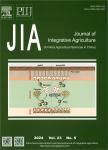Yield potential and nitrogen use efficiency of China's super rice
Yield potential and nitrogen use efficiency of China's super rice作者机构:National Key Laboratory of Crop ImprovementHuazhong Agricultural UniversityWuhan 430070P.R.China Key Laboratory of Crop Ecophysiology and Farming System in the Middle Reaches of the Yangtze RiverMinistry of Agriculture/College of Plant Science and TechnologyHuazhong Agricultural UniversityWuhan 430070P.R.China
出 版 物:《Journal of Integrative Agriculture》 (农业科学学报(英文版))
年 卷 期:2017年第16卷第5期
页 面:1000-1008页
核心收录:
学科分类:0710[理学-生物学] 0832[工学-食品科学与工程(可授工学、农学学位)] 0830[工学-环境科学与工程(可授工学、理学、农学学位)] 1004[医学-公共卫生与预防医学(可授医学、理学学位)] 0905[农学-畜牧学] 0906[农学-兽医学] 09[农学] 0901[农学-作物学] 0703[理学-化学] 0902[农学-园艺学] 0713[理学-生态学]
基 金:financially supported by the grants from the National High-Tech R&D Program of China(863 Program,2014AA10A605) the Fundamental Research Funds for the Central Universities,China(2015BQ002)
主 题:super rice yield potential nitrogen use efficiency Green Super Rice
摘 要:In 1996, a mega project that aimed to develop rice varieties with super-high yield potential (super rice) was launched by the Ministry of Agriculture (MOA) in China using a combination of the ideotype approach and intersubspecific heterosis. Significant progress has been made in the last two decades, with a large number of super rice varieties being approved by the MOA and the national average grain yield being increased from 6.21 t ha^-1 in 1996 to 6.89 t ha^-1 in 2015. The increase in yield potential of super rice was mainly due to the larger sink size which resulted from larger panicles. Moreover, higher photosynthetic capacity and improved root physiological traits before heading contributed to the increase in sink size. However, the poor grain filling of the later-flowering inferior spikelets and the quickly decreased root activity of super rice during grain filling period restrict the achievement of high yield potential of super rice. Furthermore, it is widely accepted that the high yield potential of super rice requires a large amount of N fertilizer input, which has resulted in an increase in N consumption and a decrease in nitrogen use efficiency (NUE), although it remains unclear whether super rice per se is responsible for the latter. In the present paper, we review the history and success of China's Super Rice Breeding Pro- gram, summarize the advances in agronomic and physiological mechanisms underlying the high yield potential of super rice, and examine NUE differences between super rice and ordinary rice varieties. We also provide a brief introduction to the Green Super Rice Project, which aims to diversify breeding targets beyond yield improvement alone to address global concerns around resource use and environmental change. It is hoped that this review will facilitate further improvement of rice production into the future.



